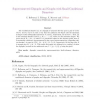Free Online Productivity Tools
i2Speak
i2Symbol
i2OCR
iTex2Img
iWeb2Print
iWeb2Shot
i2Type
iPdf2Split
iPdf2Merge
i2Bopomofo
i2Arabic
i2Style
i2Image
i2PDF
iLatex2Rtf
Sci2ools
NETWORKS
2002
2002
Superconnected digraphs and graphs with small conditional diameters
The conditional diameter D of a digraph G measures how far apart a pair of vertex sets V1 and V2 can be in such a way that the minimum out-degree and the minimum in-degree of the subdigraphs induced by V1 and V2, respectively, are at least . Thus, D0 is the standard diameter and D0 D1 . . . D, where is the minimum degree. We prove that if D 2 - 3, where is a parameter related to the shortest paths, then G is maximally connected, superconnected or has a good superconnectivity, depending only on whether is equal to /2 , ( - 1)/2 , ( - 1)/3 , respectively. In the edge case, it is enough that D 2 - 2. The results for graphs are obtained as a corollary of those for digraphs, because in the undirected case, = (g - 1)/2 , g being the girth. Key words. digraphs, connectivity, superconnectivity, fault-tolerance, diameter, girth. AMS subject classification. 05C40, 05C20 References
| Added | 22 Dec 2010 |
| Updated | 22 Dec 2010 |
| Type | Journal |
| Year | 2002 |
| Where | NETWORKS |
| Authors | Camino Balbuena, Josep Fàbrega, Xavier Marcote, Ignacio M. Pelayo |
Comments (0)

